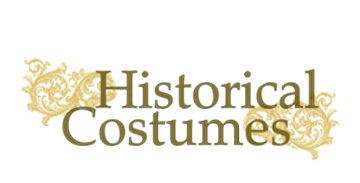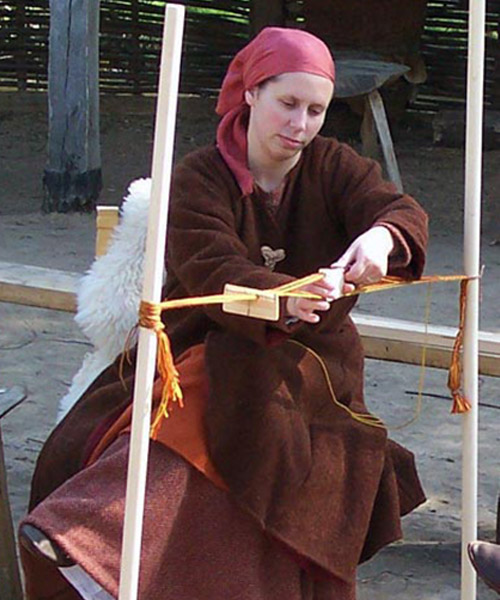
10th Century Viking Kaftan Female Version
Tabletweaving at the Eindhoven Museum in 2005
Description
The kaftan is made from brown wool and lined with linen. The neckline is v-shaped and closed with a trefoil broch. The front points are rounded. On my head I am wearing my favorite orange silk kerchief. Underneath the kaftan I am wearing a red woollen apron dress and a herringbone weave wool tunic.
Inspiration
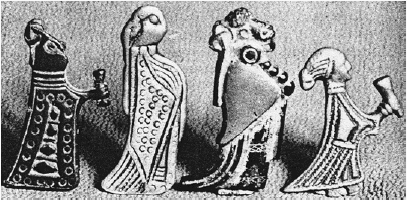

"The caftan coat is similar to a man's coat only the the front points of both panels are rounded. There can be a train addded in the back and the coat is also fastened at the throat with a brooch. The coat can be made of wool or silk. it can be lined with silk or fur."
Patterns used
No commercial pattern was used.
More information
The kaftan and especially the female version is a highly disputed garment. My kaftan has been based upon the little information I could find. Here are some quotes and images of sources available on the internet.

"Over some of the apron arrangement another garment, not necessarily a mantle, seems to have been worn.
This had sleeves, but unlike the coat of the male graves; the item was not buttoned. Instead it was fastened with a
single brooch, either a 'trefoil', 'large disc' or else a 'caterpillar' brooch. It was probably made of silk or
woollen tweed, see figure 16-i. Given the decoration encountered elsewhere in the womans wardrobe, this item too was
probably much decorated with braids, see figure 16-ii."
Source
"Viking age woman wears a coat (as opposed to her continental counter part) that is open in the front.
It is closed by a single brooch, i.e. an three armed one."
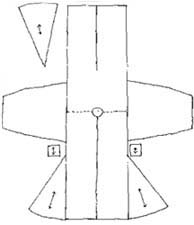 \
\
"Also unique to Birka is the men's sleeved "riding" coat closed on the chest with small
cast bronze buttons running from neck to waist; it is thought to be influenced by Persian riding coats by way of
Byzantium and the Rus lands. Some Birka women wore a similar overgarment, but instead of bronze buttons this coat was
held together by a fancy brooch pinned through two small loops that were sewn to the two sides of the garment at
the mid-chest. It is not known how long the women's coats were, but clearly if they were meant to be protective
overgarments they would need to be rather long--and require more than one closure point in front!"
"Caftan"-- The outermost layer of garb, it's a long-sleeved long coat which was pinned together at about the solar plexus with a large brooch;
it too was heavily ornamented."
"Page 201 refers to "the shawl--in later times a garment for the poor--[which] seems to have been very fashionable."
Yet most evidence for the shawl or mantle comes from the seventh and eighth centuries (Hägg 1983, 334). In the ninth
century women at some locations such as Birka and Hedeby wore a long-sleeved long coat or caftan (Hägg 1986, 65f);
this is the garment which was actually held together by the "shawl" brooches mentioned in The Viking. The caftan does
not appear in the same graves as the later gown layer; it appears to have been abandoned by many in the tenth century
in favor of the pleated smock and the gown. Many caftans were lined with linen or silk and/or trimmed with fur, silk
bands, metal knotwork, or brocaded tablet weaving."
"Outdoors, women might wear a shawl or triangular cloak, or an ankle-length coat or caftan which might either be
sleeveless or have long sleeves. The coat was quite wide at the bottom, and seems to have had almost a train coming
to a point in the back. The coat was made of heavy, high-quality dyed wool that had been felted for weather-resistance,
lined, and were often quilted with down or feathers for added warmth. The coat or shawl was fastened with a third
brooch, which varied widely in shape from wearer to wearer: examples are known of disk brooches, trefoil brooches,
equal-armed brooches or even re-worked bits of metal plundered from books or reliquaries in the British Isles.(11)"
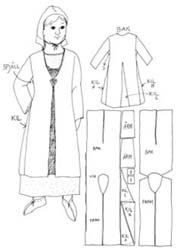
I can't read the text but the construction shown here is quite similar to that of my kaftan.
My version doesn't have a gore in the back.
Alternate views
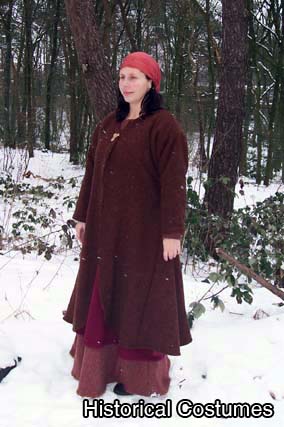
Details

13-05-2005. Added tablet woven trim to the neckline. This was my second tabletwoven band.
It is ten tablets wide and was woven with embroidery wool.


